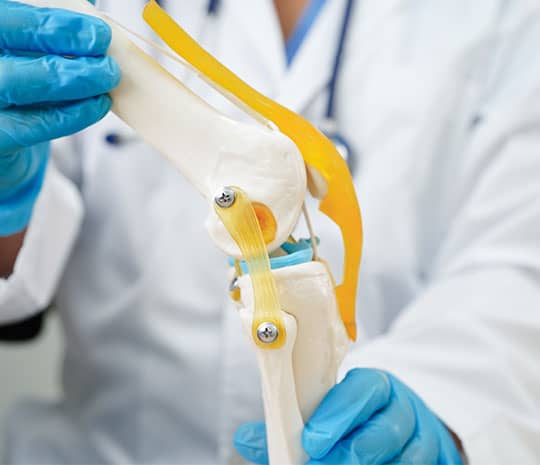Knee Replacement Complications and Active Lawsuits
Design defects in knee replacements can cause unfair pain and suffering in patients. Some are having to go through the knee replacement process all over again. Suffering patients have filed lawsuits to compensate them for the pain and expenses they are dealing with, through no fault of their own.
McIntyre Law is a compassionate and capable law firm that’s on your side. We believe communication with you helps us achieve the best outcomes for your case. That’s why we spend time getting to know you and your specific needs. At McIntyre Law, you’re part of the team, which is why we operate on a contingency fee basis. We don’t get paid until you do.
Get your knee replacement lawsuit started right away.

Is there currently a knee replacement class-action lawsuit?
There is no class-action knee replacement lawsuit. However, if you are suffering from a faulty knee replacement, you have the right to file a lawsuit. At McIntyre Law, we help people all over the country do just that. These knee replacement problems are a national problem—no matter where you live in the United States, we’re ready to help. We’re based in America’s heartland and serve all our clients as if they were right around the corner. You can call our founder Noble McIntyre anytime to talk about your case.

What to Know Before You File a Lawsuit
People who win compensation for suffering and medical expenses almost always have a lawyer working for them. That’s because going up against the legal experts from the big medical companies takes years of training. Hiring McIntyre Law levels the playing field. We’ll also help you acquire the medical records you’ll need to file your suit, such as the date of your initial surgery, if there was a revision surgery, where your knee replacement took place, and the type of knee implant you have.
What is a contingency fee?
When a lawyer works on a “contingency fee” basis, they’re agreeing to accept a fixed percentage of any monetary rewards from your lawsuit to cover their legal fees. If there are no rewards from your knee replacement lawsuit, you don’t pay the lawyer. We get paid if, and only if, you do.
The Statute of Limitations for Knee Replacement Lawsuits
If you wait too long to file your knee replacement lawsuit, you may lose your right to do so. Every state has different filing deadlines, which depend on when you started to feel the symptoms of your faulty knee replacement. Our advice? Talk to a lawyer as soon as possible. They can help you document your experience and match it with your specific state to determine if you’re eligible.
What compensation can I get from a knee replacement lawsuit?
Every knee replacement case is different, but plaintiffs typically receive cash settlements to cover the cost of treatment and to compensate for the other effects that a faulty knee replacement can have on your life. These types of compensation include:
- Medical bills
- Pain and suffering
- Financial loss

Working with McIntyre Law
Today, it’s too easy for hernia mesh manufacturers and corporations to legally outmaneuver those who’ve been injured by their products. When you work with McIntyre Law, you’re getting an experienced team of law professionals who want to make sure you’re equally represented in your hernia mesh lawsuits. For us, winning your case means not only justice for you but for all future victims.
Do you have a case for a knee replacement lawsuit?
If you had a knee replacement, and you’re now experiencing extreme discomfort, you may have a case for a knee replacement lawsuit. If you aren’t sure whether you’re eligible, give us a call. We’re here to help—and we won’t charge one single penny for your consultation. If you do have a case, we’ll start working tirelessly to get you the compensation you deserve.

Meet Our Knee Replacement Attorneys
You don’t have to suffer alone. Let us fight for fair compensation for your medical bills and suffering.

Noble McIntyre

Jeremy Thurman

Jordan Klingler

Monica Schweighart

Brenda Gómez O’Dell

Sarah Ramsey

Mario D’Angelo, Esq.

Daniel Zonas
Types of Knee Implants
Knee implants replace the weight-bearing surfaces of the knee joint in patients, with the goal of relieving chronic pain and disability. The different types of knee-replacement implants are:

Fixed-Bearing Prosthesis:
Typically used for less-active patients. Range of improvement is 20-50 percent.

Mobile-Bearing Prosthesis:
Allow for slightly more rotation than fixed-bearing prosthesis. Soft tissues must be strong enough to support this option, or knee dislocation is possible. These implants typically last longer and allow for more active lifestyles, but the surgery is more challenging.

Posterior Cruciate Ligament-Retaining:
The PCL is the ligament that runs along the back of your knee. These implants allow the doctor to keep your PCL intact, giving you a greater range of motion.

Posterior Stabilized:
If this implant is used, the PCL is removed, and the implant serves as the stabilization for the back of your leg, keeping your thigh bone from going too far forward when you bend your knee.

Bicruciate-Retaining Designs:
These implants are built to allow the patient to retain both the posterior cruciate ligament and the anterior cruciate ligament, allowing for the best range of motion and flexibility.

Gender-specific:
Knee implants were once unisex, but manufacturers have developed components that are thought to fit better with the average woman’s knee. However, your surgeon should be choosing your implant based on your unique anatomy.
Knee Replacement Complications and Side Effects
Complications from knee replacement surgery can occur on the operating table, years later due to wear and tear, or suddenly, because of a traumatic event.
Certain complications from knee replacement surgery are very common. These include:
- Infection
- Blood clots
- Knee stiffness
- Accumulation of blood in the knee
- Clicking or popping
Severe and serious complications resulting from knee replacement surgery with a faulty implant may be grounds for a lawsuit. These include:
- Long-term pain
- Loosening
- Implant rejection
- Dislocation
- Misalignment
- Fractures
Knee Replacement Recalls
Although there are currently no recalls of these products, knee implant manufacturers have had to recall their faulty products multiple times in recent years. There have been more than 500 different knee implant components recalled. If you’re wondering if your knee replacement has recalled parts, contact McIntyre Law or visit the FDA recall list to find your device.
Knee Replacements and the FDA

The FDA is responsible for deciding whether knee replacement implants are safe.
How did knee implants get approved by the FDA?
The first knee replacement implants were proposed in the 1880s, when a German surgeon suggested that ivory implants held in place with cement could replace damaged knee joints.
Modern knee replacement research picked up in the 1950s, with the development of replacement joints using metallic components. In the 1970s, researchers first debuted knee replacements that allowed for the preservation of the posterior and anterior cruciate ligaments.
Recent innovations in knee replacement implants have focused on allowing for greater range of motion, so that younger patients can stay more active.

